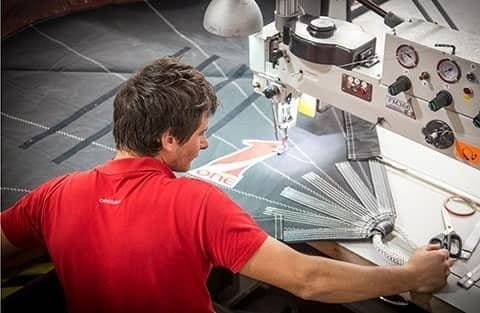The major manufacturers have not changed their basic process in the last 20 years. Laminate sails are still built using yarns which are impregnated with resin and a scrim on both sides which is coated in resin to hold the membrane together. It is this resin that breaks down over time as the sail is hoisted, tacked and folded after racing or cruising. This causes delamination, the two sides of the membrane come apart and the sail loses structural strength as there is nothing to support the yarns in place. The resin also adds weight to the sail, initially this weight can be offset by the extra strength but as the resin breaks down the weight remains for less strength.
The M3™ technology doesn’t need resin in the production of the sails and this has a number of advantages. When the yarns are impregnated with the resin and it sets, the yarns will become very hard in tension. As the sail moves and the yarns are bent and twisted, they will start to breakdown and the overall strength of the structure will be reduced. If the resin is removed, the yarns will remain soft, this means as the sail moves there is no difference in tension across the strand as the individual fibers that make up the strand can move independently. Removal of the extra yarns plus the significant mass of the resin in a laminate sail, results in a reduction in overall weight of at least 15-30%.
The M3™ skins are loaded into a vacuum bag which is pressurized to -0.95 bar, this equates to no less than 9 tons per square meter across the entire sail. The entire skin and bag is then loaded into a computer controlled oven. When the pressure and heat are applied to the sail the two layers of polymer react and fuse together to form a new layer of material in an irreversible process. This seals the two layers of Mylar together and encapsulates the structural threads. It is important to note that the polymer ‘fuses’ together and is not merely ‘stuck’ together, the resulting film is soft and flexible, delamination is not an issue anymore as there is no resin between the skins to break down over time. M3™ is a major advance from ‘mould production’ sail technology, which has demonstrated many limitations arising from: low temperature and a non uniform heating process acting on only one side of the sail (the main cause of delamination) and being physically limited in both size and shape of the ‘one piece’ sails because of the size and design of the mould.
Press-fusion process: 9 tons at 120° C
The yarns will remain soft, this means as the sail moves there is no difference in tension across the strand as the individual fibers that make up the strand can move independently.
Resin glued
When the yarns are impregnated with the resin and it sets, the yarns will become very hard in tension. As the sail moves and the yarns are bent and twisted, they will start to breakdown and the overall strength of the structure will be reduced.
It is the best choice for yachts of any length when the performance advantages and additional expense of carbon is not required.


All cruising and racing OneSails M3™ sails will be provided with a delamination warranty of three and two years respectively.
For over 15 years the OneSails design team have developed exclusive technologies to make one-piece continuous thread sails a reality for cruising and racing boats.
Features like weight, shape control and deformation resistance means better performance compared to traditional panelled sails.
Sails are designed and manufactured to the very highest standards from carefully selected components to ensure the very highest quality and durability. 4T FORTE™ membranes are exclusively made in Italy. All the assembly process is completely made in a unique factory ensuring the meeting of all the required standards.
The best sail shapes are the result of continuous analysis and experience. OneSails is at the forefront of the sailmaking industry, continually investing in research and development to ensure that the very best sail shapes are available. The success of this approach is confirmed by the vast array of racing trophies OneSails clients have won, competing at National, International and World Championship level.
A core activity for every OneSails Loft is providing first class service, support and assistance. As part of our service commitment, each OneSails Loft has a team of experts on hand to ensure that we can deliver on our service pledge. In addition to a growing number of principle lofts, the OneSails Group has an extensive network of service centres strategically placed worldwide’s coast line.

Signup our newsletter to get updates, information, news, insight or promotions: